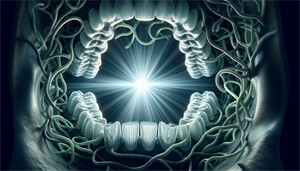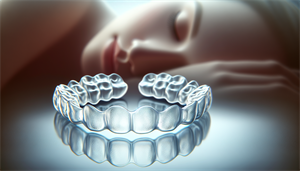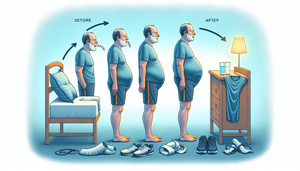Experiencing snoring problems? Invisalign could help.
Discover how Invisalign snoring relief works, including the role of teeth and jaw alignment in promoting better airflow and a noise-free night. We’ll provide insights without spoiling the full story, paving the way to potentially quieter nights ahead.
Key Takeaways
-
Invisalign aligners can mitigate snoring by improving jaw alignment, increasing airway space, and enhancing airflow during sleep, leading to improved sleep quality and reduced snoring issues.
-
Snoring and sleep apnea are often connected to oral health issues such as misaligned teeth and crowded dental arches, and Invisalign can help alleviate these conditions by straightening teeth and repositioning the jaw.
-
Invisalign treatment includes a personalized plan with a series of aligners, progress monitoring and adjustments, and can offer additional benefits such as improved dental hygiene, addressing various dental disorders, and enhanced self-confidence beyond just snoring relief.
The Role of Invisalign in Addressing Snoring Concerns

Rectifying misaligned teeth and jaw through Invisalign treatment significantly enhances breathing during sleep. The correction of these dental issues aids in improving airflow and preventing soft tissue collapse, a common contributor to snoring.
The support for the utilization of Invisalign in reducing snoring stems from extensive research and expert opinions, pinpointing the treatment’s effectiveness in addressing mouth and jaw misalignment issues. Personal testimonials often indicate that Invisalign can be an effective alternative to additional snoring mouthpieces by providing clear aligners that gradually align the jaw and teeth, thus alleviating snoring.
A considerable number of patients have experienced improved sleep quality and reduced snoring issues with the use of Invisalign aligners. This is made possible by the aligners’ ability to effectively realign the jaw and teeth, allowing for better airflow during sleep. The result? A more restful, uninterrupted night’s sleep, free from the disruptive sounds of snoring.
Jaw Alignment and Airway Space
The alignment of the jaw can be influenced by Invisalign aligners, creating a well-aligned bite. This improved alignment can enhance the openness of the airway, a critical factor for adequate airflow during sleep. By repositioning the teeth and jaw, Invisalign helps to open up the airway space, reducing obstructions and potentially minimizing snoring episodes. This better airflow during sleep, due to proper jaw alignment with Invisalign, can reduce nasal congestion and lead to a more restful night, thereby addressing issues like snoring.
Understanding the role of jaw alignment in enhancing airway space is vital to comprehend how Invisalign aids in minimizing snoring. A well-aligned jaw can significantly improve the openness of the airway, allowing for better airflow during sleep. This can result in a decrease in snoring episodes, providing a more restful and uninterrupted sleep. This marks a significant step forward in addressing snoring concerns and improving overall sleep quality.
The Use of Snoring Mouthpieces with Invisalign
Alongside Invisalign, a snoring mouthpiece can be used effectively to advance the jaw position. To accommodate the jaw advancement and maintain a proper fit, the snoring mouthpiece can be refitted by heating it. The utilization of a snoring mouthpiece with this refitting process does not negatively affect the Invisalign treatment.
The simultaneous use of a snoring mouthpiece and Invisalign aligners can offer a significant advantage in addressing snoring concerns. The mouthpiece advances the jaw position, which can be accommodated by refitting the mouthpiece. This does not interfere with the Invisalign treatment, ensuring that patients can effectively manage their snoring issues without compromising their orthodontic treatment.
Understanding Sleep Apnea and Its Connection to Oral Health

Sleep apnea, a common disorder characterized by repeated interruptions in breathing during sleep, significantly connects to oral health. The majority of sleep apnea cases involve the soft tissues in the mouth, highlighting the significant connection between this disorder and oral health. In cases of obstructive sleep apnea, issues like crowded teeth, a misaligned jaw, or insufficient room for the tongue can contribute to the condition.
Untreated sleep apnea can worsen over time, making it crucial to consider potential solutions such as a sleep apnea mouth guard, which focuses on how teeth realignment could play a role in mitigating the disorder.
Grasping the link between sleep apnea and oral health is vital for addressing snoring issues. Many cases of sleep apnea are linked to issues like misaligned teeth, crowded teeth, and insufficient room for the tongue - all of which can be effectively addressed by Invisalign treatment. By realigning the teeth, Invisalign can potentially alleviate the symptoms of sleep apnea, providing a more restful sleep and improving overall health.
Obstructive Sleep Apnea and Dental Factors
Tooth misalignment, jaw misalignment, or dental arch issues can lead to obstructive sleep apnea. By correcting these structural misalignments, Invisalign may improve airflow and increase oxygen intake during sleep, thus alleviating symptoms of sleep apnea. Invisalign aligners can help in repositioning the jaw and teeth to improve airway alignment, potentially alleviating symptoms of sleep apnea. Correcting dental issues that aggravate sleep apnea with Invisalign can create more space in the mouth and airway, which may reduce snoring.
Obstructive sleep apnea, a common sleep disorder, is often linked to dental factors such as misaligned teeth and jaw. By addressing these issues, Invisalign can potentially reduce the occurrence of obstructive sleep apnea, leading to fewer interruptions in breathing during sleep and ultimately, less snoring. This highlights the significance of Invisalign as a potential treatment solution for snoring and sleep apnea, providing a more restful sleep and improving overall health.
The Invisalign Treatment Process for Snorers

The inception of the Invisalign treatment process involves creating a customized treatment plan tailored to the examination results and specific patient needs, detailing the projected treatment steps, expected duration, and the number of aligners required. Patients receive a series of aligners to wear, beginning from the start of treatment, with each set worn for about 1–2 weeks at a time before moving to the next set in the series. This strategic series of aligners, updated every few weeks, are subtly adjusted to move the teeth incrementally towards the desired alignment. The aligners are made of medical-grade polyurethane resin and offer precise control over tooth movement, making it possible to adjust teeth horizontally, vertically, and rotationally in a comfortable manner. The Invisalign system’s focus on aligning the jaw can have a direct impact on addressing snoring problems. This is achieved by enhancing mandible posture and minimizing airway obstructions. The personalized nature of Invisalign treatment plans ensures that each individual’s process is suited to their unique dental and snoring relief needs, which is overviewed and managed throughout the treatment.
The process of Invisalign treatment for snorers includes:
-
A detailed examination and the creation of a personalized treatment plan
-
Receiving a series of aligners, each designed to move the teeth incrementally towards the desired alignment
-
Wearing comfortable aligners that offer precise control over tooth movement, making the treatment process more manageable
-
Ensuring that each individual’s unique dental and snoring relief needs are met through a personalized treatment plan
-
Enhancing the effectiveness of the treatment in reducing snoring and improving sleep
Starting Your Invisalign Journey
During consultations, emphasis is placed on personalized care in addressing sleep apnea concerns with Invisalign, ensuring a customized treatment program tailored to each patient’s unique needs. The suitability of Invisalign for snoring relief is determined through a thorough examination of teeth, the jaw, and the airway using advanced diagnostic tools, coupled with an evaluation of orthodontic needs and the severity of sleep apnea.
Invisalign aligners are custom-crafted to fit each patient’s teeth comfortably, addressing specific orthodontic issues. During the initial Invisalign consultation, patients will discuss:
-
their sleep apnea symptoms
-
orthodontic needs
-
treatment goals
-
medical history
This ensures a comprehensive understanding before beginning treatment.
Starting your Invisalign journey involves a thorough consultation process, where your sleep apnea symptoms, orthodontic needs, treatment goals, and medical history are discussed. This ensures that the Invisalign treatment plan is customized to meet your unique needs. A thorough examination of your teeth, jaw, and airway is also conducted using advanced diagnostic tools to determine the severity of sleep apnea and the suitability of Invisalign for snoring relief. The aligners are custom-crafted to fit your teeth comfortably, addressing your specific orthodontic issues and paving the way for a successful Invisalign journey.
Progress Monitoring and Adjustments
Scheduled check-up appointments for monitoring progress and making necessary adjustments are part of the Invisalign treatment. Regular check-ups with the orthodontist are essential for progress assessment and adjustments. Adhering to the prescribed wear time for Invisalign aligners each day is crucial to the success of the treatment and may influence its effectiveness in reducing snoring. To achieve efficiency in snoring reduction, it is essential to stick to the prescribed wear schedule and conduct regular follow-up care for adjustments.
Progress monitoring and adjustments are an integral part of the Invisalign treatment process. Regular check-ups with the orthodontist ensure that the treatment is progressing as planned and adjustments are made as necessary. Adhering to the prescribed wear time for the aligners each day is crucial to the success of the treatment. This consistent wear schedule, coupled with proper follow-up care and adjustments, can enhance the effectiveness of Invisalign in reducing snoring and improving sleep quality.
Additional Benefits of Invisalign Beyond Snoring Relief

Being removable, Invisalign aligners facilitate improved dental hygiene, which can lower the risk of cavities or gum disease and contribute to the reduction of snoring. Aligning teeth with Invisalign offers the following benefits:
-
Reduces the risk of periodontal disease as straight teeth are easier to clean, decreasing the likelihood of harboring harmful bacteria
-
Addresses various dental disorders such as bite irregularities, overcrowding, and spacing issues
-
Eliminates the need for dietary restrictions
-
Improves bite and aligns teeth, enhancing oral health and overall well-being, contributing to better sleep quality
-
Offers personalized treatment plans
-
Provides comfort during wear
-
Discreet teeth straightening
-
Enhances confidence and well-being
Invisalign offers a range of benefits beyond snoring relief. Some of these benefits include:
-
The aligners are removable, facilitating improved dental hygiene and lowering the risk of oral health issues such as cavities or gum disease.
-
The treatment addresses various dental disorders, such as bite irregularities and overcrowding, improving oral health.
-
Invisalign can positively impact self-esteem and overall well-being.
-
The aligners are comfortable to wear.
-
Invisalign is discreet and hardly noticeable.
These benefits make Invisalign an appealing solution for those seeking to improve their sleep quality and overall health.
From Crowded Teeth to a Straighter Smile
Clear aligners of Invisalign braces, also known as Invisalign clear braces, guide teeth into a better position, unlike traditional metal brackets and wire. Invisalign’s clear aligners can enhance self-esteem, particularly in teenagers, by providing a discreet way to straighten teeth and improve appearance without the visual presence of metal braces. Consistent overnight wear of Invisalign aligners contributes to the long-term success of the treatment by maintaining teeth in their new position.
The transformation from crowded teeth to a straighter smile is one of the most striking benefits of Invisalign. Unlike traditional braces, Invisalign uses clear aligners to guide teeth into a better position, providing a more discreet approach to teeth straightening. This can greatly enhance self-esteem, particularly in teenagers who may be self-conscious about their appearance.
Furthermore, the consistent overnight wear of the aligners contributes to the long-term success of the treatment, ensuring that the teeth remain in their new position and the benefits of the treatment are sustained.
Enhanced Self-Confidence with a Better Smile
Both teeth straightening and sleep improvement are addressed by Invisalign clear braces, enhancing mood and self-image. The benefits of Invisalign extend beyond physical improvements, also contributing to enhanced self-confidence. By straightening the teeth and improving sleep, Invisalign can bring about a noticeable improvement in mood and self-image.
This emotional well-being is a significant benefit of Invisalign treatment, underscoring the broader positive impacts of the treatment beyond the physical changes to the teeth and jaw.
Comparing Invisalign to Traditional Snoring Solutions

Designed to be both subtle and comfortable, Invisalign aligners offer an advantage over traditional snoring solutions like CPAP machines. Patients often find it easier to comply with wearing Invisalign aligners during sleep compared to CPAP machines, attributing to the comfort of Invisalign aligners. Invisalign clear aligners offer a less cumbersome alternative to traditional solutions like CPAP and standard mouthguards, making them a preferred choice for many seeking relief from snoring.
When it comes to addressing snoring, Invisalign aligners offer several advantages over traditional solutions like CPAP machines. Here are some advantages of Invisalign aligners:
-
They are designed to be subtle and comfortable, making them easier to wear during sleep.
-
This increased comfort can enhance compliance with treatment, contributing to more effective snoring management.
-
In contrast, traditional solutions like CPAP machines and standard mouthguards can be cumbersome and uncomfortable.
These advantages make Invisalign a preferred choice for many individuals seeking relief from snoring.
Continuous Positive Airway Pressure (CPAP) Machines
Delivering steady air pressure to maintain open breathing passages during sleep, CPAP machines are essential in treating sleep apnea and reducing snoring. Advanced CPAP machines include features like a ‘ramp’ to start with lower air pressure and bi-level positive airway pressure for variable pressure during inhaling and exhaling, aiming to enhance user comfort. Despite features for comfort, some users still find CPAP machines uncomfortable due to factors like the mask fitting, air pressure sensation, or noise. Common issues leading to the search for CPAP alternatives include leaky masks, difficulty falling asleep, claustrophobia, dry mouth, and the device’s general inconvenience.
Continuous Positive Airway Pressure (CPAP) machines are a common traditional solution for snoring and sleep apnea. These machines work by delivering steady air pressure to keep breathing passages open during sleep, which is essential in sleep apnea treatment and reducing snoring. However, despite advancements designed to enhance user comfort, some users still find CPAP machines uncomfortable due to factors like mask fitting, air pressure sensation, or noise. These issues can lead to a search for alternatives, such as Invisalign, which provides a more comfortable and less cumbersome solution for managing snoring.
Standard vs. Custom Aligners for Snoring
Offering a personalized fit for users, Invisalign aligners are smooth, custom-made, and comfortable to wear. Unlike standard snoring mouth guards that use a one-size-fits-all model, Invisalign provides a customized fit tailored to the individual’s mouth, enhancing management of snoring.
Standard snoring mouth guards typically adopt a one-size-fits-all model, which may not provide the best fit for every individual. In contrast, Invisalign aligners are custom-made and tailored to fit each individual’s mouth perfectly. This personalized fit enhances user comfort and can improve the management of snoring.
Furthermore, the smooth material of Invisalign aligners offers a more comfortable wear experience, contributing to higher user compliance and increasing the effectiveness of the treatment in reducing snoring.
Lifestyle Tips for Maximizing Invisalign's Snoring Reduction Potential
Certain lifestyle modifications, along with using Invisalign aligners, can enhance the snoring reduction potential of the treatment. Invisalign aligners allow for a balanced diet, which can be advantageous, as diet plays a role in maintaining a healthy lifestyle that may impact snoring severity.
In addition to the Invisalign treatment, adopting certain lifestyle modifications can further enhance snoring reduction. One such modification is maintaining a balanced diet.
The Invisalign aligners are removable, allowing for unrestricted eating, which plays a crucial role in maintaining a healthy lifestyle. A balanced diet can help manage weight, which is a significant factor in snoring severity. So, while Invisalign works to align your teeth and improve airflow, a healthy diet can contribute to overall health and further aid in reducing snoring.
Nighttime Wear and Care Routines
Patients are advised to wear their aligners for at least 20 to 22 hours per day, including sleep time, to optimize the effectiveness of Invisalign in reducing snoring. Invisalign aligners can be advantageous for nighttime wear due to their custom-made smooth plastic material, enhancing comfort during sleep. Many patients find sleeping with Invisalign more comfortable than daytime wear since the aligners are less likely to irritate gums and cheeks during sleep.
Invisalign wearers can minimize discomfort by sleeping on their back or side and practicing good oral hygiene before placing aligners back in at night. Following proper care routines, including cleaning the aligners, is important to prevent plaque buildup and maintain oral health during Invisalign treatment.
A crucial aspect of maximizing the snoring reduction potential of Invisalign is the adherence to nighttime wear and care routines. Patients are advised to:
-
Wear their aligners for at least 20 to 22 hours a day, including sleep time.
-
Clean the aligners and practice good oral hygiene.
-
Follow the recommended wear schedule consistently.
This consistent wear schedule, coupled with proper care routines, can enhance the effectiveness of the treatment. Moreover, many patients find sleeping with Invisalign more comfortable than daytime wear, making it easier to adhere to the recommended wear schedule.
Managing Nasal Congestion and Sleep Position
Forcing an individual to breathe through their mouth, nasal congestion can exacerbate snoring, which can worsen during orthodontic treatments like Invisalign. Here are some tips to help reduce nasal congestion and snoring in conjunction with Invisalign treatment:
-
Use nasal strips or nasal sprays before bedtime to help reduce nasal congestion and improve breathing patterns.
-
Maintain a regular schedule for changing air filters in the home and use a humidifier to minimize nasal congestion.
-
Optimize sleep position by sleeping on your side to keep the airways open and improve airflow.
-
Elevate the head using pillows or an adjustable bed to reduce nasal congestion and complement the snoring relief offered by Invisalign aligners.
These strategies can help improve breathing and reduce snoring during Invisalign therapy.
In addition to the wear and care routines, managing nasal congestion and optimizing sleep position can further enhance the effectiveness of Invisalign in reducing snoring.
Nasal congestion can worsen snoring by forcing an individual to breathe through their mouth, a situation that can be exacerbated during orthodontic treatments like Invisalign. However, this can be effectively mitigated by using nasal strips or sprays before bedtime, changing air filters regularly, and using a humidifier to treat snoring.
Furthermore, optimizing the sleep position to maintain open airways can complement the snoring relief provided by Invisalign, with sleeping on one’s side often recommended to reduce snoring and improve airflow.
Summary
In conclusion, Invisalign aligners offer a revolutionary approach to reducing snoring and improving sleep. By aligning the teeth and jaw, they enhance airflow and reduce obstructions during sleep.
The treatment process is personalized, comfortable, and discreet, making it an ideal solution for those seeking to improve their sleep quality and overall health. In addition to its primary function of aligning teeth, Invisalign also offers numerous other benefits such as improved dental hygiene, reduced risk of periodontal disease, and enhanced self-esteem.
With the right lifestyle modifications, such as managing nasal congestion and optimizing sleep position, the effectiveness of Invisalign in reducing snoring can be significantly enhanced.
Frequently Asked Questions
How does Invisalign work in reducing snoring?
Invisalign works to reduce snoring by correcting misaligned teeth and jaw, thereby enhancing airflow during sleep and preventing soft tissue collapse. This can reduce snoring if your teeth are out of alignment.
Can I use a snoring mouthpiece with Invisalign?
Yes, you can use a snoring mouthpiece with Invisalign without negatively affecting the treatment. Make sure to refit the mouthpiece during your treatment to make sure it fits correctly.
What are the benefits of Invisalign beyond snoring relief?
Invisalign offers benefits such as improved dental hygiene, reduced risk of periodontal disease, enhanced self-esteem, and better sleep quality. These benefits go beyond simple snoring relief.
Is it comfortable to wear Invisalign aligners during sleep?
Yes, wearing Invisalign aligners during sleep is generally more comfortable for many patients as they are less likely to irritate the gums and cheeks.
How does nasal congestion affect snoring, and how can it be managed during Invisalign treatment?
Nasal congestion can worsen snoring by causing mouth breathing, but it can be managed during Invisalign treatment by using nasal strips, sprays, changing air filters, and using a humidifier.


